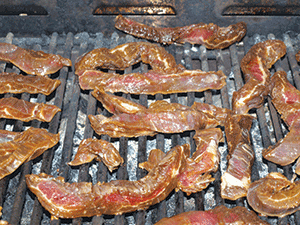The term bushmeat, also called wildmeat and game meat, according to Wikipedia, refers to meat from non-domesticated mammals, reptiles, amphibians and birds hunted for food in tropical for
 In many African cities nowadays, eating bushmeat has become a status symbol, and the demand has steadily increased.
In many African cities nowadays, eating bushmeat has become a status symbol, and the demand has steadily increased.
Although the practice earns hunters and traders quick cash in the short-term, it is ultimately unsustainable, and denies the wider community and future generations the opportunity to benefit from wildlife. Similarly, commercial harvesting and the trade in wildlife is considered a threat to biodiversity.
Prices of wildmeat are rapidly increasing, making hunting more profitable, even when hunters must travel greater distance in search of game. There are some very common ones like bush rat, cats, snakes, birds, hare and antelope.
Bushmeat can be prepared and cooked in a number of ways – the most common method being smoking – before selling to consumers.
Nutritional benefits
Researchers emphasise the importance of bushmeat as the best source of animal protein. Though there is little data on the nutritional composition of commonly consumed bushmeat species, what is known suggests that bushmeat provides an equivalent and, in most cases, greater quality food than domestic meat.
Wild animals are good sources of carbohydrates compared to domesticated animals from similar environments. The protein content of bushmeat ranges from 16 to 55 per cent compared to domestic animals’ 11 to 20 per cent. Snails, for example, provide a good source of protein, are low in fat, and are exceptionally high in iron, calcium and vitamin B.
In addition, bushmeat is often a good source of minerals and vitamins. They are generally more nutitious and delicious because, the wild animals feed on all the fresh foods in the forest, and have in no way grown rapidly like the domestic animals which eat some processed foods.
Wild meats contain low-density lipoprotein (LDL), known as bad cholesterol, they are recommended by nutrition experts. LDL is one of the five major groups of lipoproteins.
Downside
The Ebola virus, which the primary host is suspected to be fruit bats, has been linked to bushmeat. Between the first recorded outbreak in 1976 and now, the virus has transferred from animals to humans only 30 times, despite large number of bats being killed and consumed each year.
Although primates (apes) may carry the disease, having contracted the disease from bat droppings or fruit touched by the bats. Like humans, it is often fatal for the primate. Therefore, people are advised to abstain from friut bats. It is also advisable to cook the bushmeat well enough to kill all sorts of germs that might be in it.
Results of research on wild chimpanzees in Cameroon indicate that they are naturally infected with the simian foamy virus and constitute a reservoir of HIV-1, a precursor of the acquired immunodeficiency syndrome (AIDS) in humans. There are several distinct strains of HIV, indicating that this cross-species transfer has occurred several times. Researchers have shown that HIV originated from a similar virus in primates called simian immunodeficiency virus (SIV); it is likely that HIV was initially transferred to humans after having come into contact with infected bushmeat.
Animals used as bushmeat may also carry other diseases such as smallpox, chicken pox, tuberculosis, measles, rubella, rabies, yellow fever and yaws. African squirrels (Heliosciurus, Funisciurus) have been implicated as reservoirs of the monkeypox virus in the Democratic Republic of the Congo. The bubonic plague bacteria can transfer to humans when handling or eating prairie dogs.
Facts about bushmeat
The term “bushmeat” may evoke images of gorillas and chimpanzees – but the majority of the bushmeat harvested consists of porcupine, pouched rat and small antelopes. Monkeys are hunted in large numbers in some areas, but they represent a small percentage of the biomass of bushmeat.
The volume of the bushmeat trade in West and Central Africa was estimated at one to five million tonnes per year at the turn of the century. According to the Centre for International Forestry Research (CIFOR) in 2014, approximately five million tonnes were still being consumed per year in the Congo Basin, according to Wikipedia
For the people of this region, bushmeat represents a primary source of animal protein in the diet, making it a significant commercial industry. According to a 1994 study in Gabon, annual sales were estimated at $50 million. The study found that bushmeat accounted for more than half of meat sold in local markets, with primates representing 20 per cent of the total bushmeat.
Nevertheless, the hunting of bushmeat is widely seen as unsustainable. This can lead to the disruption of ecological and evolutionary processes, changes in species composition within ecosystems and a general reduction in biological diversity, creating “empty forests” because they lack any large animal species.
Men are generally more involved in hunting and transport of bushmeat, while women are more heavily involved in the sale. Evidence shows that there are even different bushmeat taste preferences between men and women.
Not only rural people in the Nigeria eat bushmeat – urban people also consume it.
Bush meat are sold the most on the highways.















